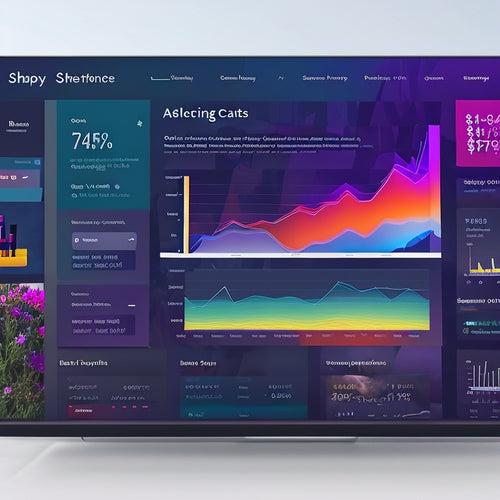Enhancing Customer Engagement With Video Integration
Share
In today's digital age, customer engagement is crucial for businesses seeking to establish a strong online presence. One effective way to enhance customer engagement is through the integration of video content, particularly shoppable videos.
This article explores the power of video integration in driving customer engagement and highlights why shoppable videos are considered the future of e-commerce. Additionally, it provides strategies for implementing shoppable videos effectively and examines successful case studies that demonstrate their impact.
Finally, it discusses the future prospects of video integration and its potential in further enhancing customer engagement.
- Incorporate interactivity in videos, such as clickable elements or quizzes, to enhance customer engagement.
- Utilize data-driven insights to analyze viewer data, understand preferences and behaviors, and enable personalized recommendations and targeted marketing campaigns.
- Optimize videos for mobile devices to improve accessibility, convenience, customer experience, and increase engagement and reach.
- Explore the impact of virtual reality technology on video integration, such as providing immersive shopping experiences and virtual try-on and product testing.
The Power of Video Integration in Customer Engagement
Video integration has proven to be a powerful tool in enhancing customer engagement by providing an interactive and visually appealing platform for customers to engage with products or services. The impact of video content on customer loyalty cannot be overstated. By incorporating videos into their marketing strategies, businesses have the opportunity to create a more immersive and engaging experience for their customers.
One way to measure the effectiveness of video integration in customer engagement is through analyzing metrics such as click-through rates, conversion rates, and time spent watching videos. These metrics can provide insights into how well the videos are resonating with customers and whether they are driving desired actions.
Furthermore, studies have shown that video content tends to capture consumers' attention more effectively than other forms of media. This is because videos combine visual and auditory elements, making them more memorable and engaging. Additionally, videos allow businesses to convey emotions and tell stories in a way that static images or text alone cannot achieve.
In conclusion, video integration offers immense potential for enhancing customer engagement. By leveraging the power of interactive visuals and storytelling, businesses can create a sense of belonging with their audience while also measuring the effectiveness of these strategies through various metrics. Embracing video integration can therefore be a strategic move towards creating stronger connections with customers and ultimately driving business growth.
Why Shoppable Videos are the Future of E-commerce
Shoppable videos are anticipated to revolutionize the e-commerce industry due to their ability to seamlessly integrate product information and purchasing options within video content. This innovative approach combines the power of video marketing with a convenient shopping experience, providing numerous benefits for both consumers and businesses.
One of the key advantages of shoppable videos is their ability to enhance customer engagement. By incorporating clickable links or interactive elements directly into the video, viewers can easily access more information about featured products and make purchases without having to navigate away from the video itself. This streamlined process eliminates any potential barriers that may prevent customers from completing a purchase.
Furthermore, shoppable videos tap into current video marketing trends by leveraging the growing popularity of online video consumption. With people spending more time watching videos on various platforms, businesses can take advantage of this trend by integrating shoppable features into their content. This not only increases brand exposure but also provides a seamless transition between product discovery and purchase.
In conclusion, shoppable videos offer a promising future for e-commerce by combining the engaging power of video with convenient purchasing options. By embracing this emerging trend, businesses can create immersive experiences that captivate audiences while driving sales.
Strategies for Effective Shoppable Video Implementation
One effective strategy for implementing shoppable videos is to carefully select the featured products and ensure they align with the target audience's interests and preferences. By understanding the needs and desires of the target audience, businesses can curate a collection of products that are most likely to resonate with viewers and lead to higher conversion rates. This involves conducting thorough market research, analyzing consumer behavior data, and identifying trending or popular items within the target demographic.
Another important aspect of effective shoppable video implementation is addressing implementation challenges. One common challenge is integrating seamless purchasing options within the videos without disrupting the viewing experience. To overcome this obstacle, businesses can utilize interactive overlays or clickable hotspots that allow viewers to explore product details and make purchases without leaving the video interface.
Additionally, measuring return on investment (ROI) is crucial in determining the success of shoppable video campaigns. Businesses should track key performance indicators such as click-through rates, conversion rates, and overall sales generated from these videos. This data provides valuable insights into which strategies are working effectively and allows for optimization of future campaigns.
In conclusion, carefully selecting relevant products, overcoming implementation challenges, and measuring ROI are essential strategies for successful shoppable video implementation. By following these guidelines, businesses can enhance customer engagement and drive sales through this innovative e-commerce tool.
Case Studies: Successful Shoppable Video Campaigns
This discussion explores successful shoppable video campaigns implemented by various brands. It highlights their achievement in high customer engagement. By examining these case studies, valuable lessons can be learned from the strategies and tactics employed by these brands.
Businesses can then adapt and apply these proven strategies to enhance their own customer engagement through shoppable videos. This can ultimately drive sales and increase brand loyalty.
Examples of Brands That Have Achieved High Customer Engagement
Several brands have successfully achieved high customer engagement by integrating shoppable videos into their marketing strategies.
Video integration offers numerous benefits in enhancing customer engagement. Firstly, it provides a more immersive and interactive experience for customers, allowing them to visualize products in action. This can lead to increased trust and confidence in the brand, ultimately driving sales.
Secondly, shoppable videos allow for seamless shopping experiences as customers can directly purchase products showcased in the video without leaving the platform or website.
Key metrics to measure customer engagement with shoppable videos include click-through rates, conversion rates, and time spent watching the video. By analyzing these metrics, brands can gain insights into the effectiveness of their video integration strategies and make data-driven decisions to further optimize customer engagement efforts.
Overall, brands that have effectively utilized shoppable videos have witnessed higher levels of customer engagement and improved business outcomes.
Lessons Learned from Their Strategies and Tactics
Lessons learned from the strategies and tactics employed by brands that have successfully utilized video integration in their marketing include:
- The importance of creating immersive and interactive experiences for customers.
- Enabling seamless shopping within the video platform or website.
- Using key metrics to measure effectiveness and make data-driven decisions.
These brands have understood the significance of engaging customers through visually captivating content that allows them to actively participate in the shopping experience. By incorporating features such as shoppable videos, they have made it easier for customers to make purchases directly from the video itself, resulting in increased conversions.
Additionally, these successful brands have recognized the value of analyzing key metrics like click-through rates, engagement duration, and conversion rates to gain insights into their campaigns' effectiveness. Armed with this knowledge, they can make informed decisions on how to optimize future video integration strategies for enhanced customer engagement.
How to Adapt and Apply These Strategies to Your Business
To successfully implement video integration strategies in a business, it is crucial to adapt and apply the tactics utilized by brands that have effectively incorporated immersive and interactive experiences, seamless shopping options, and data-driven decision-making. Adapting strategies from successful brands can help businesses enhance customer engagement with video integration.
Here are five techniques to consider:
-
Utilize immersive experiences: Create videos that immerse customers in your brand story and products, allowing them to connect on a deeper level.
-
Incorporate interactivity: Make videos interactive by including clickable elements or quizzes that engage viewers and encourage participation.
-
Enable seamless shopping: Integrate shoppable videos that allow customers to make purchases directly from the video, providing a convenient and frictionless shopping experience.
-
Embrace data-driven insights: Analyze viewer data to understand their preferences and behaviors, enabling personalized recommendations and targeted marketing campaigns.
-
Optimize for mobile: Ensure your videos are mobile-friendly, as most customers access content on their smartphones.
By adapting these strategies and applying the techniques mentioned above, businesses can effectively enhance customer engagement through video integration.
The Future of Video Integration and Shoppable Videos
The future of video integration and shoppable videos holds great potential for enhancing customer engagement and driving sales. One area that is expected to have a significant impact on video integration is virtual reality (VR). VR technology enables users to immerse themselves in a virtual environment, creating an interactive and engaging experience. By incorporating VR into video integration, businesses can provide customers with a more immersive shopping experience. For example, customers can virtually try on clothing or test out products before making a purchase.
Another aspect that will shape the future of shoppable videos is influencer marketing. Influencers have gained immense popularity in recent years, as they have the ability to sway consumer opinions and behaviors through their social media presence. With the rise of shoppable videos, influencers can showcase products within their content and provide direct links for viewers to make purchases. This form of marketing not only enhances customer engagement but also builds trust between consumers and brands.
Overall, the future of video integration and shoppable videos looks promising. Incorporating virtual reality technology into video integration and leveraging influencer marketing are two key strategies that businesses should consider adopting to enhance customer engagement and drive sales. By staying informed about emerging trends in these areas, businesses can position themselves at the forefront of this rapidly evolving landscape.
Frequently Asked Questions
How can businesses measure the success of their shoppable video campaigns?
Businesses can measure the success of their shoppable video campaigns by evaluating the effectiveness and return on investment (ROI). This involves analyzing metrics such as click-through rates, conversion rates, sales revenue generated, and customer engagement levels.
What are some best practices for creating engaging shoppable videos?
Creating interactive experiences and increasing conversion rates are crucial when creating engaging shoppable videos. Best practices include clear product demonstrations, compelling storytelling, seamless integration of shopping features, and personalized recommendations to enhance customer satisfaction and drive sales.
Are there any limitations or challenges in implementing shoppable videos on different e-commerce platforms?
Challenges and limitations in implementing shoppable videos on different e-commerce platforms include technical compatibility issues, integration complexities, and varying platform capabilities. Overcoming these obstacles requires strategic planning, expertise, and adapting to the specific requirements of each platform.
How can businesses effectively promote their shoppable videos to increase customer engagement?
Promoting strategies for shoppable videos involve leveraging various channels, such as social media and email marketing, to reach target customers. Effective customer interaction can be achieved through personalized recommendations, interactive features, and seamless integration with the e-commerce platform.
What are some innovative features or technologies that can enhance the effectiveness of shoppable videos in customer engagement?
Interactive elements and personalization features are key innovative technologies that can enhance the effectiveness of shoppable videos in customer engagement. These features allow customers to actively engage with the content, creating a personalized and immersive experience that fosters a sense of belonging.
Related Posts
-

Top Shopify SEO Apps for Boosting Website Performance
This article aims to examine the importance of utilizing Shopify SEO apps in order to enhance website performance. S...
-

How Do I Optimize My Shopify Speed
The optimization of Shopify speed is a topic of interest for many online businesses seeking to enhance their website...
-

Creating Product Bundles on Shopify: Simple Methods and Strategies
This article examines the process of creating product bundles on Shopify, focusing on simple methods and strategies....


